
Access to European Union funds provides the Republic of Croatia with the necessary finances for investments in infrastructure construction, as well as green and digital transition. Thanks to this, the country can implement numerous reforms and projects faster and with better quality, boosting its economy and creating new opportunities, especially in green and clean technologies. In an interview for Energy Portal Magazine, Damir Habijan, Croatian Minister of Economy and Sustainable Development, talked about the green transition, investments in renewable energy sources and how the Republic of Croatia plans to achieve its goals and become climate neutral.
Q: The Republic of Croatia is committed to implementing the Green Plan for Europe, which aims to make the continent climate-neutral by 2050. How do you plan to accomplish your goals?
A: The Republic of Croatia fully supports the implementation of the Green Plan for Europe and is fully committed to making Europe the first climate-neutral continent by 2050. In this context, all EU Member States started drafting National Energy and Climate Plans (NECP) in 2019, which set three main goals related to decarbonization: reduction of CO2, the share of renewable energy sources in final consumption and increase of energy efficiency. All the stated goals are set at the EU level. It should be noted that these goals have been constantly raised during the last five years, both because of the Fit for 55 package and the REPowerEU plan, devised due to the aggression against Ukraine, which largely led to the drastic jump in energy prices. That is why the European Commission has set a clear goal with the REPowerEU plan to rid the EU of its dependence on fossil fuel imports, especially from unreliable partners, as soon as possible. The plan mentioned above boosts the effort related to decarbonization, which, in addition to reducing greenhouse gases, should also reduce the European Union’s dependence on energy imports from third countries.
IN FOCUS:
- EU SUPPORT FOR GREEN TRANSITION PROJECTS IN SERBIA
- PRECISE STRATEGIES AND PLANS FOR MITIGATING THE CONSEQUENCES OF CLIMATE CHANGE
- CHARGE&GO PUSHES THE BOUNDARIES OF E-MOBILITY
Q: What does the National Plan for Recovery and Resilience bring, and when will it be implemented?
A: The National Plan for Recovery and Resilience is another important document that envisages a series of reforms and investments that will ensure a green and digital transition and better functioning of the state administration. The document was created based on the EU Regulation and is a direct consequence of the COVID-19 pandemic. In it, we, as a state, have highlighted which reforms we consider necessary and proposed activities and investments with which we will implement them. On the other hand, the plan brought significant financial resources, which initiated a series of economic activities. For example, after the NPOO Addendum worth about 4.5 billion euros was approved in December 2023, the total amount of funds we have at our disposal increased from 5.5 to 10 billion euros. That is about 15 per cent of our annual GDP. The significance of this is shown by the fact that this percentage is the highest in the EU; that is, no other member state has agreed on such a high percentage of NPOO funds in relation to their economy size. The Republic of Croatia has received 3.5 billion euros so far. It should be noted that Croatia is among the first three EU countries that sent the fourth request for disbursement of payment under the NPOO auspices, and we expect the payment of an additional 163 million euros in grants soon. I would like to note the example of the energy sector, to which, after the revision of the NPOO, 1.4 billion euros were allocated. A large part of that money is aimed at the green transition. The rest is invested in the security of supply and diversification of sources for Southeast Europe. The green transition is also financed in other sectors, such as water management, waste, etc.
Q: How significant are investments in renewable energy sources?

A: Investments in renewable energy sources (RES) are significant, and considering our geographical position, we have great RES potential. In the southern part of the country, we can see large-scale investments in wind farms and solar power plants, as well as in northern Croatia. Integrated solar power plants, installed on roofs or in the vicinity of houses, other buildings and factories, are particularly important to us. They increase the share of renewable energy in the total energy mix and ensure the inclusion of individuals and small business owners and their active participation in the energy transition. Equally important are the large hydropower plants that also produce the so-called green electricity. Besides wind, water, and sun, geothermal energy and bioeconomy (biogas and biomass) should also help us with this. Linking biogas and biomass to agricultural production ensures a green transition. In terms of geothermal energy, we have highly favorable conditions for using the geothermal energy accumulated underground in the Pannonian Basin, which has a geothermal gradient as much as 60 per cent higher than the European average. To use this potential as efficiently and effectively as possible, the 2030 Geothermal Potential Development Plan of the Republic of Croatia was drawn up due to the need to ensure the further development and use of domestic renewable potential, which should be utilized more widely in energy transformation for the production of electricity, i.e. for heating and cooling. So, regarding renewable energy sources, the Energy Development Strategy sets a target of at least 2,500 new MW in producing electricity from renewable sources by 2030. Still, thanks in large part to the National Recovery and Resilience Plan and our investments in the transmission power grid, I assure you that we will achieve this goal earlier, that is, in 2028.
Interview by Milica Radičević
Read the whole interview in the new issue of the Energy portal Magazine NATURE CONSERVATION.



